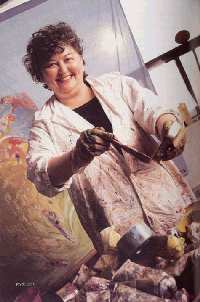| Joyce Wieland
Canada's Greatest Female Artist of the 20th Century
Joyce Wieland: 1931 - 1998
Written by Suzanne MacNevin "I think of Canada as female. All the art I've been doing or will be doing is about Canada." - Joyce Wieland. Joyce Wieland was a very patriotic artist, that much is for certain. She LOVED Canada. And unlike other artists who usually promoted a country's military (like many artists did for Napolean during the Neo-Classicist/Romanticist periods), Joyce Wieland promoted something entirely different. SEX! Yes, in addition to patriotism, Joyce Wieland loved making art about sex and romance. If you ever watch the movie she wrote, produced and directed (The Far Shore) you will come away with that conclusion too. A bit boring at the start of the movie, The Far Shore is about a woman who gets married and while on vacation with her husband, she meets an artist named Tom (this story is really a fictionalized version of the death/disappearance of Tom Thompson, the famous Canadian landscape painter who mysteriously disappeared in northern Ontario). She meets Tom, they fall in love and they have wild water sex. So in addition to being about sex/romance, The Far Shore is also very much about Canada (in a humourous, quirky kinda way). Especially the businessman in the red plaid jacket who is a farce of the Royal Canadian Mounted Police. That said, she also made many other short films and even funny documentary called "The Rats Life and Diet in North America", which is a farce on Vietnam War draft dodgers. Its a story of a group of rats (the draft dodgers) being chased by a cat (the United States military) while on their way to Canada.
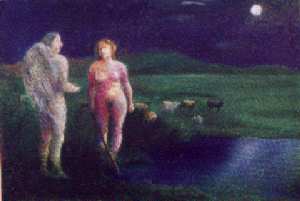
Joyce Wieland - She will remain in the phenomenal world filled with ignorance with her sheep, and not go with him - 1983. Oil on canvas, 25.5 x 38.2 cm. Collection of the Artist. Many of Wieland's paintings are autobiographical in nature, showing that she was extremely sex-oriented person and extremely passionate about issues of feminism and politics. Sorry, there isn't more "feminist-ish" pieces here.
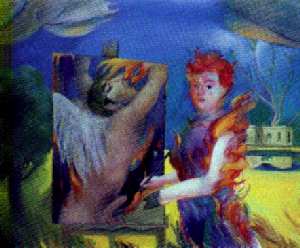
Joyce Wieland - The Artist on Fire - 1983. Oil & canvas, 106.7 x 129.5 cm. Robert McLaughlin Gallery, Oshawa. Wieland's most famous "painting" is not really a painting. Its a quilt called "Reason Over Passion". She also made several other versions, like Passion Over Reason and a French version too. The one below was bought by the Canadian Prime Minister Pierre Elliott Trudeau and hung in his home at 24 Sussex drive while he was Prime Minister. During a legendary argument with estranged wife, Trudeau apparently ripped the quilt and Wieland had to patch it back together. The phrase "Reason over Passion" is actually based on a quote Trudeau himself made, so there is some irony in how this quilt came to be and its history.
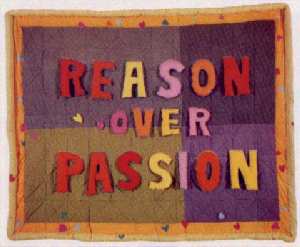
Joyce Wieland - Reason Over Passion - 1968. Quilted cloth assemblage, 256.5 x 302.3 cm. National Gallery of Canada, Ottawa
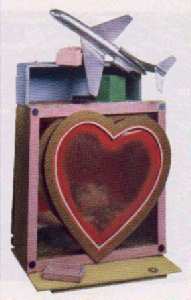
Joyce Wieland - Young Woman's Blues - 1964. Mixed media construction, 44.5 x 33.0 x 22.9 cm. University of Lethbridge Art Collections. Bio in a Nutshell: Born in Toronto in 1931, Wieland studied commercial art, went on an art trip to Europe, became a film animator, met Avant-garde artist Michael Snow and had her first solo show in 1960 at the Isaacs Gallery. Her painting Redgasm (1960) is a good example of her early abstract works that also dealth with sex. An alternative name would be "Red Orgasm". In 1963 she and Michael Snow moved to New York City and she gained popularity there, and also began experimenting with more materials. She did a series of paintings about plane crashes and disasters like sinking boats. When she returned to Canada she began doing many more patriotic themes like O Canada (1970) and The Maple Leaf Forever (1972). She also made many of her short experimental films during the 1960s. The height of her career was "True Patriot Love", a solo exhibition of her work which opened on Canada Day in 1971. Many of her quilts and paintings were shown in the exhibition, and the extra fame led to her being commissioned to design a Canadian stamp. Later in her career, she stayed out of the limelight (being a successful famous artist is tiring) and worked on paintings for the rest of her career. I however feel that it is her paintings during the early 1980s (the most sexual of them all) which are her overall best works. Joyce Wieland died in 1998. She is often regarded as Canada's first feminist artist, and certainly one of Canada's most famous female artists.
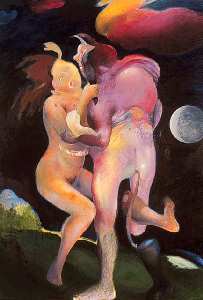
Joyce Wieland - Paint Phantom - 1984. Oil & canvas, 170.2 x 121.9 cm. Purchased 1985 by the National Gallery of Canada.
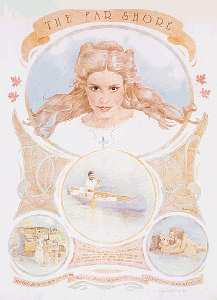
Joyce Wieland - Poster for "The Far Shore" - 1976. Colour photo-offset lithograph on wove paper, 74.2 x 54 cm. Purchased 1977 by the National Gallery of Canada.
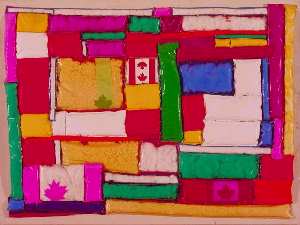
Joyce Wieland - Confedspread - 1967. Plastic and cloth, 146.2 x 200.4 cm. Purchased 1968 by the National Gallery of Canada.
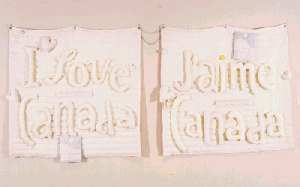
Joyce Wieland - I Love Canada - J'aime Canada - 1970. Cotton and metal link chain, 153.1 x 304.7 cm. MacKenzie Art Gallery, University of Regina Collection.
|
|
